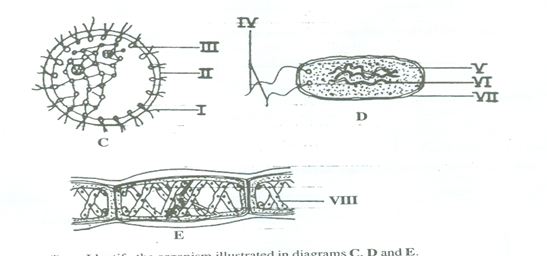Question 4
-
The diagrams below illustrate the various forms in which cells exist. Study the diagrams carefully and use them to answer questions 4(a) to 4(c).

- (i) Identify the organisms illustrated in diagrams C, D and E.
- (i) In what forms do diagrams C, D and E exist?
- (i) State four economic importance of D.
- (i) Which structures on C and D are used for locomotion?
- State one similarity between the organism in diagram D and: (i)The organism in diagram C………………………………………………………
C …………………………………………………….............................
D ……………………………………………………………………….
E ………………………………………………………………………. [3 marks]
(ii) Name the parts labelled I to VIII.
I. ………………………………….. V. ……………………….
II. ………………………………….. VI. ……………………….
III. ………………………………….. VII. ………………………….
IV. …………………………………... VIII. ………………………….. [4marks]
C ……………………………………………………………………….
D ……………………………………………………………………….
E ……………………………………………………………………….[3 marks]
………………………………………………………………………………
………………………………………………………………………………
……………………………………………………………………………….
………………………………………………………………………………. [4 marks]
(iii) Give three differences between the organisms in diagrams C and E.
C E
…………………………………….. ……………………………………
…………………………………….. …………………………………….
…………………………………….. …………………………………… [3 marks]
……………………………………………………………………………………
…………………………………………………………………………………….
…………………………………………………………………………………….
……………………………………………………………………………………. [4 marks]
(ii) List four diseases in humans caused by D.
…………………………………………………………………………
………………………………………………………………………….
……………………………………………………………………………
……………………………………………………………………………….[4 marks]
…………………………………………………………………………………..
…………………………………………………………………………………... [2 marks]
(ii) Suggest the instrument used to view D.
…………………………………………………………………………………. [1 mark]
(ii) a cell from the organism in diagram E ………………………………………….[2 marks]
Observation
The candidates that performed well in this question were able to identify the organisms in the diagrams correctly.
Many candidates lost marks for wrong identification of labelled parts, wrong spelling of technical terms and ignorance about the economic importance of bacteria.
The expected answers are:
4 (a) (i) Identification
C- Volvox
D- Bacterium
E- Spirogyra
(ii) Label of parts
I-Flagellum V-Cytoplasm
II-Protoplasmic/Cytoplasmic strand VI-Chromosome/genetic material
III-Cell VII-Cell wall
IV-Flagella VIII-Chloroplast
NOTE: Spelling must be correct to score
(b) (i) Forms in which they exist
C- Colony
D- Singly/chains/cluster/twos
E- Filament
(ii) Effect of C and E living separately
- Volvox cell/C will soon die; because the cells are specialized/there is division of labour/ so each individual cell cannot carry out all the physiological processes needed for its existence.
- Spirogyra cell/E will survive/multiply/grow; because there is no specialization among the cells/each cell can live on its own.
(iii) Differences between organisms C and E
Volvox/C |
Spirogyra/E |
- Identical cells form round mass/colony/spherical |
Identical cells are joined end to end in filament/filamentous; |
- Chloroplasts are circular |
Chloroplasts are spiral; |
- Nucleus is inconspicuous |
Nucleus s conspicuous; |
- Flagella present/motile |
Flagella absent/non-motile; |
- Gelatinous sheet absent |
Gelatinous sheet present; |
- Pyrenoid absent |
Pyrenoid present; |
- Cells are dependent physiologically |
Cells are independent physiologically; |
- Division of labour takes place |
No division of labour |
(c) (i) Economic importance of D
- Harmful bacteria cause diseases in living things;
- they are responsible for food spoilage;
- useful bacteria are used industrially in the manufacture of some food items/butter/cheese/yoghurt/vinegar;
- they bring about decay;
- improve soil fertility;
- used in the production of some antibiotics/medicine.
(ii) Diseases in humans caused by the bacteria/B
- Gonorrhoea; syphilis; tuberculosis; cholera;
- dysentery; typhoid; pneumonia;
- cerebrospinal meningitis; tetanus; diphtheria;
- whooping cough/pertussis;
- food poisoning; any correctly named human bacterial disease.
(d) (i) Structures on C and D used for locomotion
C- Flagellum/flagella/I
D- Flagellum/flagella/IV
(ii) Instrument to view D
Microscope(s)
(e) (i) Similarities between organism D and C
- Both have organs of locomotion/flagellum/flagella;
- Both have protoplasm/cytoplasm;
- Both have cell wall.
(ii) Similarities between organism D and a cell from organism E
- Both have cell wall;
- Both have protoplasm/cytoplasm.
